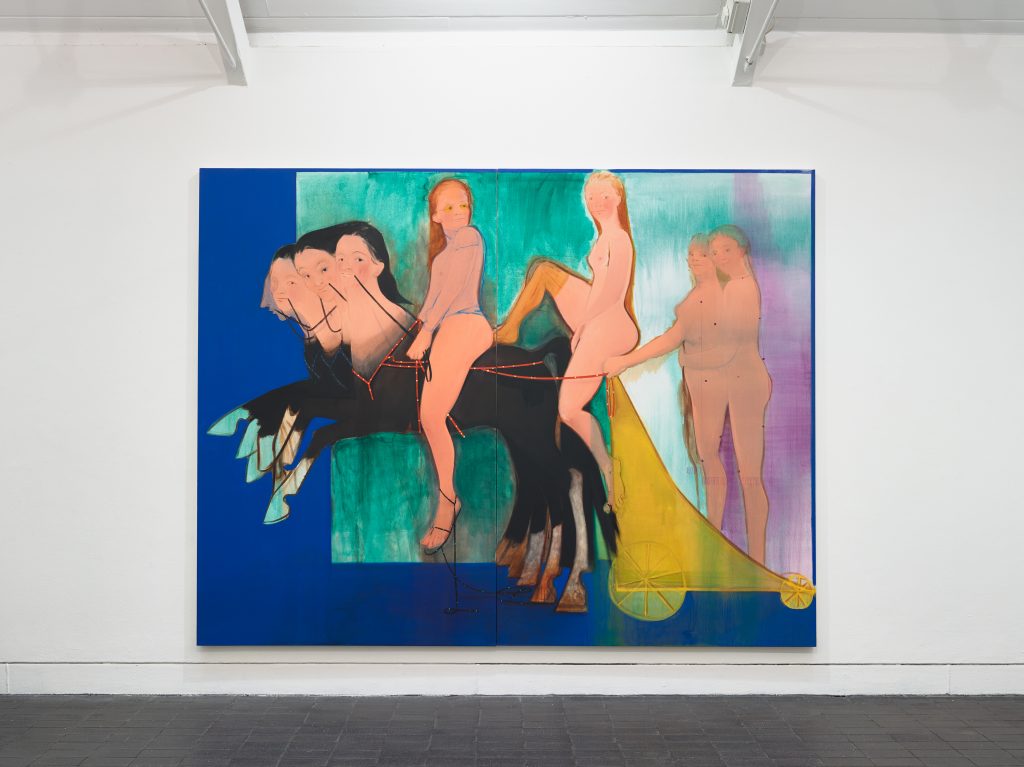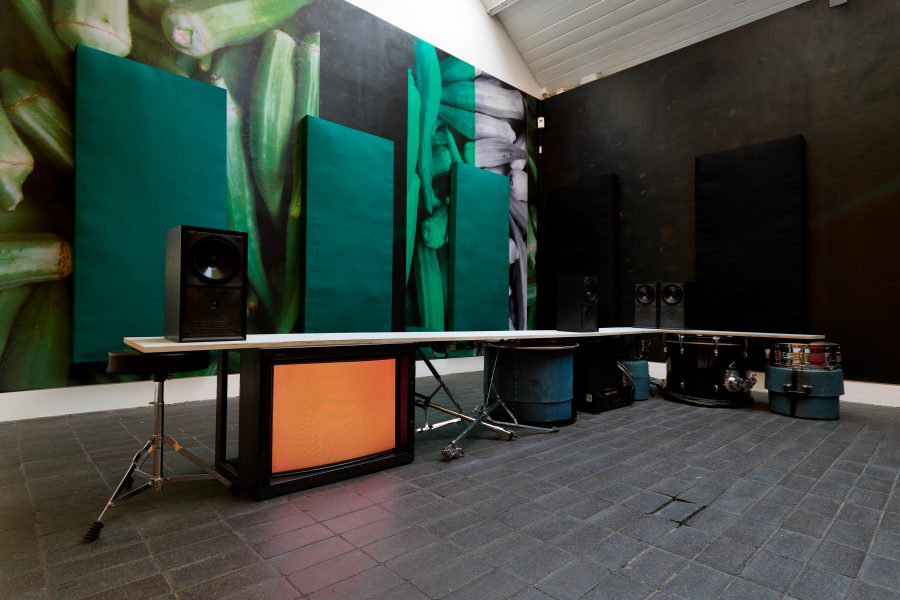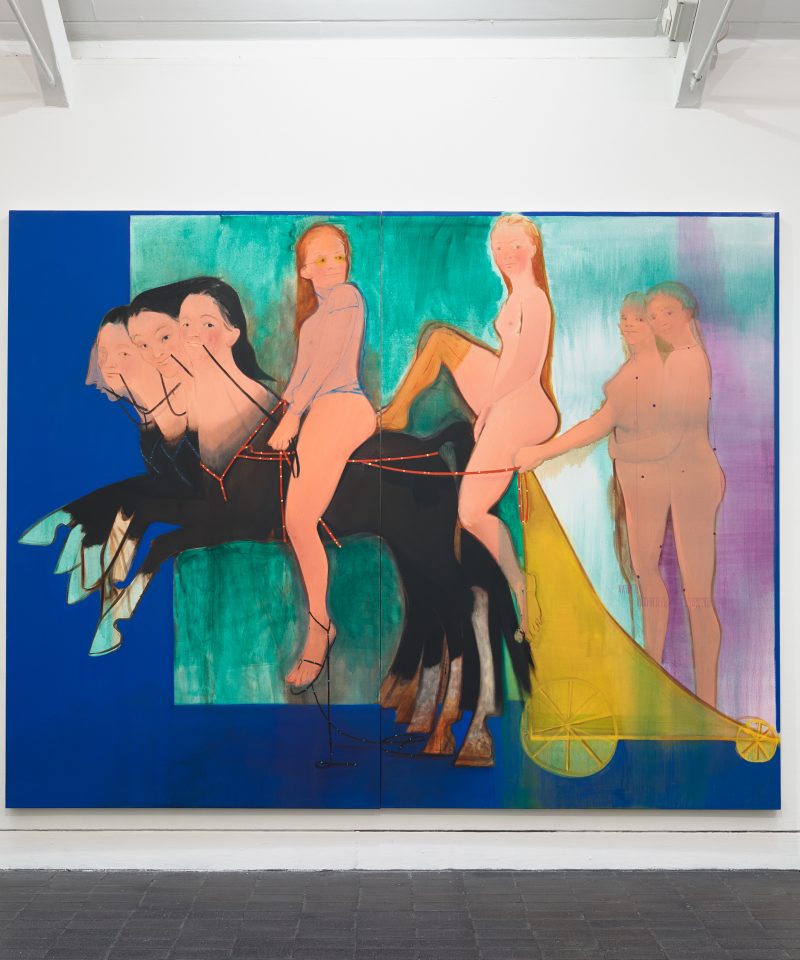‘Am I that which I observe or that which observes me?’
Leonora Carrington (1970)
In current times it is impossible to look at an image of a female form, especially a nude image, be it painting or photograph, and not consider the dilemma of the male/female gaze. Surrounded by the mythic females of Sofia Mitsola’s paintings in Jerwood Solo Presentations 2019, their ambiguous forms and suggestive observations, your first thoughts are to wonder where the agency lies, with those beholding or those beheld. Yet at closer inspection, these beguiling female creatures become less about the issue of objectification and more about the duality of the Greek mythic creatures.
Entering Mitsola’s room at Jerwood Space, you are confronted with Sirens, Sphinxes and Centaurs. This all-female cast transfixes you in the centre of the room, caught in a crossfire of hypnotising gazes. Mythology, and thusly art and fiction, have long entertained the hybrid as a fantasy of the animal and human fused into one being. These representations, we are told, reflect the primal and instinctual animal within us versus the civilised and socially responsible human part as the paintings depict the subjects of Greek myth as opposed to the narrative patterns associated with them.[1] The hybrid as a vehicle, be it visual, literary, mythological or metaphorical, serves as a paradox that embodies female beauty and beastly ugliness in the form of seductive tricksters. Mitsola’s paintings explore female identity as negotiations between how female mythic creatures are historically represented and what these symbols hold today.
The painting Sirens (oil on canvas, 190 x 210cm) is arguably the most erotically charged on display. The winged seducers of Greek mythology were the first representatives of what we now call the mermaid. In Homer’s Odyssey these female creatures reside on a rocky island at sea, luring sailors to their death with the sound of their libidinal voices and bewitching beauty.[2] The two figures in the painting clearly evoke an act of seduction as they lay naked across what appears to be a bed. The main figure’s posterior is placed centre stage while her shoe suggestively hangs off her foot, pearls twisting around her finger. Yet these figures are not portrayed as a physical hybrid in the painting. The name, in this instance, dictates what the mythical creatures symbolise, as if warning the viewer. Perhaps these sirens represent the psychological challenge the myth embodies?
The largest work on display, Chariot, (oil on canvas, 210 x 170cm) depicts a group of four nude female figures riding a chariot led by female-headed horses. Centaurs, with the upper body of a human and the lower body of a horse, are portrayed in Greek mythology as uncivilised and barbaric. As mythic creatures they represent the human tendency to anarchy while Lapiths represent emergent civilised culture.[3] Depicted in Chariot their front legs rear up as the female figures calmly hold the reins. Some of the figures are partially dressed – a stockinged leg, bloused torso – accentuating their nudity. Their gazes address the viewer with different dispositions from defiant, coy, friendly and indifferent . The simplistic style of the female figures’ depiction lends itself to the mythical beings. We know these are not real people drawn from life.
The smallest work on display illustrates another mythic creature, Toy Sphinx (oil on canvas, 40 x 30cm), which is a repeating motif in Mitsola’s work. The sphinx has had a long history of secrecy and intrigue, being viewed by many as guardians of knowledge and as speaking in riddles. In Greek mythology the Sphinx has the head of a woman, the wings of a griffin and the body of a lion. The Sphinx guarded the entrance of the Greek city Thebes and posed anyone who passed a riddle.[4] If answered incorrectly, they were killed.[5] Mitsola’s Toy Sphinx is playful as even the name evokes images of small dogs that women carry around in handbags. With a female human-head, the body of a sitting animal (dog? lion?) and serpent-head tail, it sits discreetly among the bigger and bolder paintings in the room.
Historically, the abundant manifestations of the Greek symbols of Siren, Sphinx and even Centaur are not fixed. The Siren was first described with the body of a bird and head of a woman, and later manifested with a fish tail. How they developed from bird-winged to fish-tailed remains unclear and reiterates the ambivalences around the indecisive definitions of their feminine identity. What is left undisputed is their seductive and dangerous nature. The Sphinx is most commonly known as a creature with a man’s head and body of a lion guarding the pyramids of the Egyptian pharaohs. However, Greeks adopted the mythical creature in their literature as a treacherous monster with the head of a woman, the haunches of a lion, wings of an eagle and the tale with a serpent’s head. The wide-ranging and polymorphous forms of Greek symbols highlights the rigidity of the Greek ideal of femininity, precariously positioned between the dangers of excessively aggressive and defensive female sexuality.
Most pertinently, these symbols call attention to the plasticity in female identity that remains unresolved today. When describing “Mythological persons” the Swiss linguist and semiotician Saussure described the notion of ascribed identity as ‘a ghost resulting from the fleeting combination of two or three ideas. . . The association – that we sometimes cherish – is but a soap bubble.’[6] Mitsola’s paradoxical and provocative characters tease the viewer with these slippery binaries (sexual and aggressive, self-reference and all-knowing, wild instinct and social responsibility). In Sisterly Affections (oil on canvas, 140 x 240cm), the bemused figures lie lackadaisical or perhaps they are depicted falling. Their gaze looks out, undisturbed. However, some of the figures in Chariot (on the wall opposite) assert their presence in the room defiantly, while the provocative Sirens are seductive. All of these figures seem to address the internal inconsistencies of how it feels to inhabit a feminine body, how it feels to be looked at and how it feels to be touched.
Even without knowing the complicated symbolism which lies behind the paintings, they are overtly sexual. In the case of Sirens, before it is anything else it is a painting of sexual provocation. Laughter in the Dark II (oil on canvas, 210 x 170cm), named after and inspired by the novel of the same name written by Vladimir Nabokov, portrays a female in the negative space of the painting wearing only what appears to be a corset.[7] The tension lies in how the figure contradicts herself. Her arms and upper body are open while her bottom half is turned to the side. In John Berger’s discussion of the nude in ‘Ways of Seeing’, he distinguished the differences between nudity and nakedness. “To be naked is to be oneself. To be nude is to be seen naked by others and yet not recognised for oneself. A naked body has to be seen as an object in order to become a nude… Nakedness reveals itself. Nudity is placed on display”[8] It is difficult to decipher if Mitsola’s contemporary figures are nude or naked in Berger’s sense or even if they are taking a feminist stance as a radical nude. You could almost say that they embody the paradox of being both naked and nude simultaneously. Berger goes on to explain that Dürer believed that the ideal nude ought to be constructed by “taking the face of one body, the breasts of another, the legs of a third, the shoulders of a fourth, the hands of a fifth – and so on.”[9] This exemplifies how the identity of the female depicted traditionally in paintings was seen to be irrelevant and composed of multiple entities. Looking at Mitsola’s work through Dürer’s ideal nude, Mitsola turns this idea on its head using the paradigm of Greek myth to develop adversarial female identities.
The consistent tensions in all five paintings play out a paradox of feminine duality. Some of the figures seem to be naked, while others seem to be nude (in Berger’s sense). They are also clothed yet naked (or nude) in some cases as we can still see underneath the clothes. The figure’s facial expressions address the viewer, sometimes seducingly, sometimes formidable. The figures are positioned facing the viewer whilst others are sometimes turned away. They contain any or all of these features simultaneously. Even the flattened contemporary style is the antithesis of classical figure painting yet the subjects are of Greek mythological descent, which are traditionally portrayed classically. The combination of all of these paradoxes posited to the viewer in one room leave the viewer uncertain of how to hold themselves, essentially forcing the viewer to embody the inner inconsistencies the very paintings they are looking at are grappling with.
The question, ‘Am I that which I observe or that which observes me?’ posited by the Surrealist painter Leonora Carrington,[10] similarly acknowledges this unstable notion of female identity wrapped up in past and present representations and implies that the culture we operate within defines us. In the same essay entitled What is a woman? Carrington claimed she was born a ‘female human animal.’[11] Mitsola’s paintings attempt to negotiate the mythological and sexual representations posed upon female identity and reconcile the coexistence of multiple beings in one entity that feminine ideals have struggled with since antiquity. In the process, Mitsola makes manifest the ambivalence, polarities and tensions that can emerge when confronted with symbols of hybrid mythological creatures, delving into this notion of the ‘female human animal’ that still resonates today
Endnotes
- For insight into the chronological representations of mythic creatures, see Edith Hamilton’s Mythology (Hatchett, 2017)
- For the history of Sirens and their relation to Mermaids please see Meri Lao’s Seduction and the Secret Power of Women: The Lure of Sirens and Mermaids (Inner Traditions/Bear, 2007)
- A relief sculpture on the south side of the Parthenon’s Doric frieze famously depicts the story of the Centauromachy where the Lapiths battle with the Centaurs at the wedding feast of Pirithous.
- ‘What Creature goes on four feet in the morning, two at noon and three in the evening?’
- The story of the Sphinx can be found in Jane Cahill’s Her Kind: Stories of Women in Greek Mythology (Broadway Press, 1995)
- Saussure’s discussion of mythological identity is unpacked in Scylla: Myth Metaphor Paradox by Marianne Govers Hopman (Cambridge University Press, 2013)
- The main female character in Nabokov’s story is that of a young and attractive actress who has an affair with an older art critic, takes advantage of him and eventually kills him.
- John Berger, Ways of Seeing, p.54
- Ibid. p.62
- Leonora Carrington, What is a Woman? in ‘Surrealist Women: An International Anthology’ ed. Penelope Rosemont (1998)
- Female Human Animal is also the name of the film shot in the real-life contemporary art world, about a creative woman disenchanted with what modern life has to offer her, haunted by Leonora Carrington’s artwork at the Tate retrospective. (dir. Josh Appignanesi, 2018)





